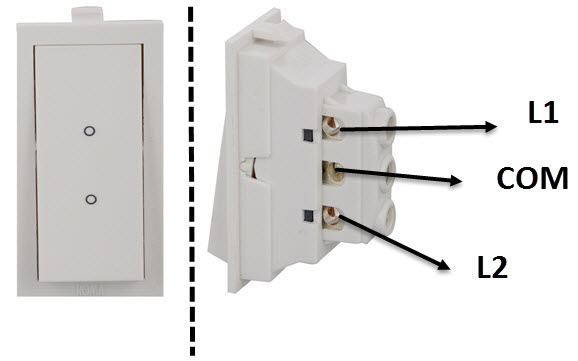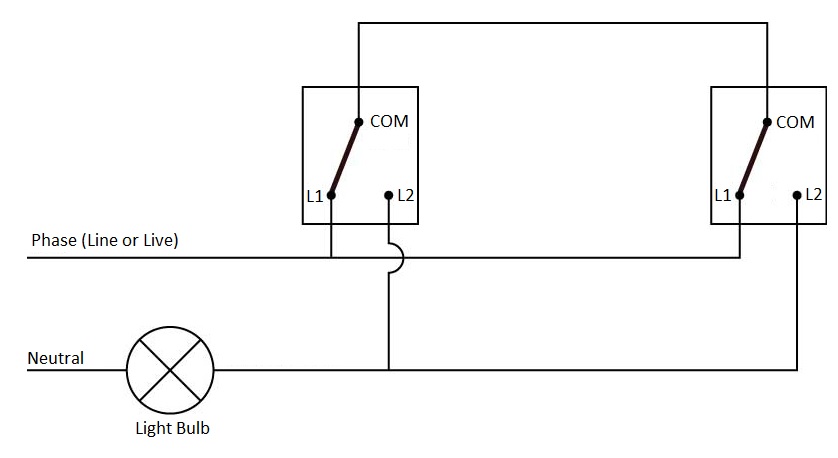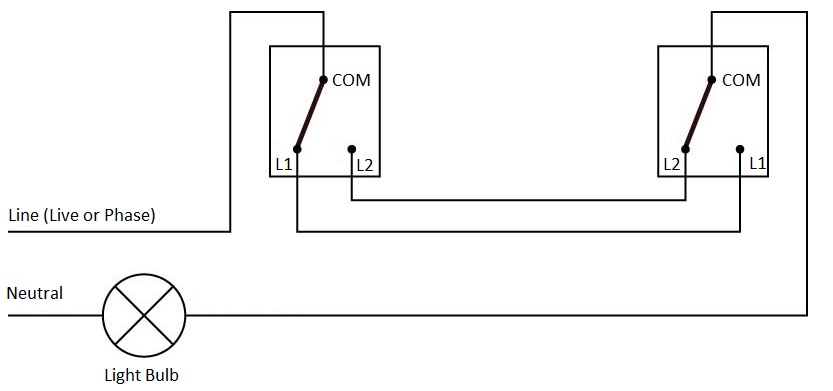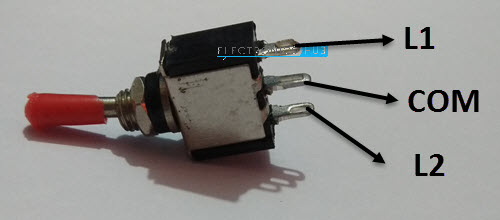In this tutorial, we will learn about a simple yet interesting concept called the 2 Way Switch. It is also called as a Staircase Switch, as you can control a single load, like a light bulb, from two different places, like either end of a staircase.
WARNING: This is just a theory explaining how a typical 2 Way Switch works. It is not a user guide on how to install or wire a 2-way switch. If you are planning to implement a similar setup in your home, then definitely consult a professional as the process involves working with 230V AC Supply (or 110V AC, depending on where you live).
How to Wire a 2 Way Switch?
As I have already mentioned in the introduction paragraph, a two way switch is very useful in staircase lighting as you can turn on the light just before you start to climb the stairs and once you reach upstairs, you can turn off the light simply by toggling the switch placed near the top of the staircase.
There are a couple of ways in which you can make a two-way switch connection. One is an older method, which is not often used now-a-days and the other is a more modern and safer version which is being implemented in industrial as well as residential applications. Let us take a look at both these wirings.
Before proceeding, an important component called a Two-Way Light Switch is the main element of the 2 Way Switching, irrespective of the type of wiring used. It is a standard single pole switch with three terminals.
The three terminals are usually named COM, L1 and L2, but sometimes COM, 1 Way and 2 Way are also used. In one position, the COM and L1 are connected while in the second position, the COM and L2 are connected.
This type of connection is typically called a “Break before make” design, as the first connection has to be broken before making the second connection.
The following image shows the front and back view of a typical household two-way switch.
Standard 2 Way Switch Wiring
The first way of wiring uses a couple of Two-Way Light Switches with a 3-wire control. The following is the simple schematic of a three wire 2-way switch wiring.
You can observe in the schematic that both the COM terminals are connected together. The L1 terminals of both the switches are connected to line (or phase or live) of the AC Supply.
The L2 terminals of both the switches are connected to one terminal of the light bulb while the other terminal of the light bulb is connected to neutral of the AC power supply.
From the schematic, you can easily visualize how the wiring works. In the state shown in the above image, the light is off. If either of the switches is toggled, the light turns on. To turn off the light, you can toggle the other switch.
When we compare this setup with digital electronics, then this is similar to an Ex-OR Gate, where the status of the light (on or off) depends on the COM terminals of terminals of both the switches connected to respective L1 and L2 terminals.
Switch 1 COM Light L1 OFF L1 ON L2 ON L2 OFF
Switch 2 COM
L1
L2
L1
L2
This method is recommended as both the line and neutral wires come from the same lighting circuit (or breaker) even though it uses more wire.
Alternative Method
The next wiring design is an old system which you might find in some older homes and industrial settings. It is also called as two wire control wiring.
This wiring system is not recommended for modern implementations and if you are planning to install a new setup or replace an older one, then the previous wiring must be used.
I have included the alternative wiring method just as a reference and I will also explain its drawbacks.
Coming to the actual wiring, the following schematic shows the implementation of a two-wire control two-way switch.
L1 terminals of both the switches are connected together and L2 terminals of both the switches are also connected together. Coming to the COM terminals, the COM terminal of the first switch is connected to phase (or line or live).
The COM terminal of the second switch is connected to one end of the light bulb while the other end of the light bulb is connected to the neutral of the AC Supply.
In the default state (as shown in the schematic), the light is off. But when either of the switches is toggled, then the light turns on. In terms of digital electronics, this configuration is similar to an Ex-NOR Gate.
Switch 1 COM Light L1 ON L1 OFF L2 OFF L2 ON
Switch 2 COM
L1
L2
L1
L2
Even though this method saves cable, it is not being preferred anymore as the Phase and Neutral may come from different lighting circuits (or breakers).
Another major flaw is with respect to electromagnetic interference. We know that any current carrying conductor emits electromagnetic radiations. If the Live and Neutral wires are placed in close proximity, they cancel each other’s EM Radiation.
But in this wiring, the neutral and live wire are being run separately at different parts of the house, making the wires a giant induction loop. This will definitely cause interference problems with other EM and RF Signals.
Example
I do not have the Two-Way Light Switches to demonstrate the working but I thought I would make a similar setup using a couple of Single Pole Double Throw (SPDT) Toggle Switches and an LED. The SPDT Toggle switch can be considered as a Two-Way Light Switch as it has three terminals and works very similar to the two-way light switch.
The following image shows a typical SPDT Toggle switch with its terminals.
For wiring, I have selected the standard way with a 3.7V Lithium Ion Battery as the power supply. It worked flawlessly.
The post How a 2 Way Switch Wiring Works? appeared first on Electronics Hub.




0 Comments